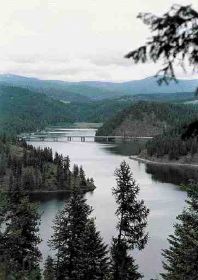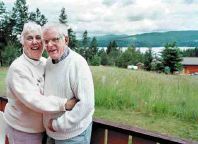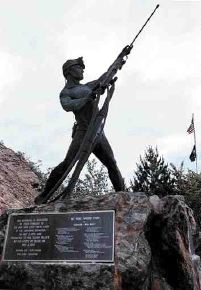Silver Valley dilemma:
Superfund -- solution or a bigger
problem?
Tribes & EPA want funds
to clean up
a century
of pollution
By Ken Miller
The Idaho Statesman
 |
| Kim Hughes |
| North Idaho's Lake Coeur d'Alene is part of the 3,700-square-mile
Coeur d'Alene Basin, where the Environmental Protection Agency is studying
contamination problems caused by a century of mining. |
 |
| Kim Hughes |
| Bob and Jeri McCroskey have their dream home in Harrison, overlooking
Lake Coeur d'Alene, and they are concerned that efforts to clean up the
area will be inadequate. |
 |
| Kim Hughes |
| This memorial is dedicated to the 91 men who were killed in
the nation's second-worst hard-rock mining disaster at Sunshine Mine on
May 2, 1972. |
Small-town Idaho isn't supposed to be like this.
Seven-year-olds are paid $20 to have blood drawn from the crook in their
arms. Toddlers read comic books warning them not to eat snow, suck icicles
or make mud pies. Playgrounds are sterilized.
Around the neat and trim residential homes, the yards have been dug
up, and trucked-in soil lies atop plastic liners -- more than 1,400 cubic
yards so far. Gardeners are told to grow only plants that produce edible
parts above ground -- no onions, carrots or potatoes. Inside the houses,
government-lent super-vacuums scoop up crud from the living rooms to be
studied in laboratories.
No, Kellogg is no normal small town. Nor is nearby Wallace. Or Smelterville.
Or Pinehurst.
All are nestled in the stunning beauty of the Gem State side of the
Bitterroot Range. And all are part of a spectacular gigantic downhill plumbing
system that continues to flush 100 years worth of contamination into the
Coeur d'Alene watershed.
Kellogg is ground zero for the area's worst mining pollution. The old
Bunker Hill smelter, where mountains of rocks were turned into a king's
ransom in minerals until a 1973 fire ruined the smelter's main environmental
filters, now is one of the nation's most infamous environmental Superfund
sites.
More troubling to Idahoans up and down the 50-mile Silver Valley is
that the whole drainage, also known as the Coeur d' Alene Basin, now is
thought of as a Superfund site as well. While the designation hasn't been
formalized, the basin nonetheless is considered one of the largest contamination
zones in the United States.
The Bunker Hill Superfund site in Kellogg is 21 square miles. At issue
now is how to deal with mining contamination in the rest of this 3,700-square-mile
valley. EPA and state officials agree recent federal court decisions have
cleared the way for the entire basin to be treated as if it were a Superfund
zone. The EPA said it won't take severe measures to clean up the region.
Rather, it said, it will work with the state to focus on contamination
"hot spots."
"We do at this point have the ability to use Superfund dollars if mining
in an area poses an unacceptable risk to human health and the environment,"
EPA Coeur d'Alene Basin Project Manager Mary Jane Nearman said Friday.
While she said a long-running lawsuit by the Coeur d'Alene Tribe and the
federal government remains in place to force mining companies to help pay
for the cleanup, she said a recent court decision has freed EPA to attack
expensive contamination problems across the basin as if they were part
of a larger Superfund area.
The problem reaches beyond North Idaho. All Idahoans will pay. Regardless
of whether the cleanup costs $4 billion, as some want, or $250 million,
the state must pay 10 percent of the cleanup.
On the ground
In her Studio Z salon in Wallace's historic Brooks Hotel, 47-year-old
Kathy Zanetti said she realizes that mining in the old days polluted the
Silver Valley. But she also said things aren't bad enough to consign the
massive Coeur d'Alene Basin to Superfund status, which would put it on
the same level as places such as New York's dreaded Love Canal.
"My family has been here for five generations in this valley," Zanetti
said as she worked with a customer in the hotel's salon. "... To say that
the lead contamination in this valley has created this huge health threat
just isn't right. I understand part of what they're doing, but (mining)
is also part of our heritage."
It's also part of the problem here, where almost everyone has ties to
the industry. Fathers, grandfathers, and great-grandfathers worked in these
mines, built the homes, ran the hardware stores, and poured drinks for
generations. Almost all of it done with the paychecks from miners.
But that heritage has come at a price.
Bob and Jeri McCroskey have their dream home on the eastern shore of
Lake Coeur d'Alene in Harrison, where the contaminated Coeur d'Alene River
flows into one of Idaho's most prized natural assets. An abandoned Union
Pacific rail bed nearby was constructed with contaminated mine tailings.
"They claim they're cleaning it up, but they're not cleaning it up"
Jeri McCroskey said. "You've got to be very careful with this lake. All
the talk is about lead, but there are other minerals. You have to consider
how these contaminants work together. We're dealing with 100 years of contamination,
and it's not going to be solved overnight. There is no quick fix."
History and heritage
It's been more than 100 years since the owners of a local mercantile
store gave prospector Noah Kellogg $20 and a jackass to go find gold in
the local hills. Legend has it Kellogg's jackass hit paydirt, stopping
short in a creek to gaze at the glittery galena rocks.
And the Silver Valley was born. Cradled in the world's richest silver
lodes, mines sprouted throughout the basin, building fortunes not only
for the men who staked the local prospectors but also for the towns that
served them.
The mines helped win World War II, with thousands of tons of lead and
zinc hauled up from the ground. More lead and zinc come out of these mines
than any others in the country. There's a good chance that the lead in
your car battery, the zinc in the film in your camera, and the silver in
your heirloom cutlery came from these mines. More than $5 billion in minerals
has been unearthed here in the past century.
The Coeur d'Alene Mining District fast became one of the highest metal-producing
areas in the world; it also is one of the most contaminated, according
to the EPA. New technologies and environmental rules have reduced new contamination,
but the few remaining mines are being told they must pay for the sins of
their predecessors.
Pollution
Abandoned mines and mills cover about 600 square miles in the eastern
portion of the 3,700-square-mile Coeur d'Alene Basin. The Bureau of Land
Management has identified 1,075 areas impacted by 550 mines and tunnels;
46 mill sites; 170 rock dumps and pits; 28 inactive mine tailing areas
or ponds and two active tailing ponds; and 70 stream and flood areas affected
by mining.
As recently as 1964, 2,200 tons of mining waste flowed into the Coeur
d'Alene River every day. In recent times, the threat has been from airborne
lead that has contaminated the ground kids play on and the gardens tilled
by their parents.
In 1983, a decade after the fire in the Bunker Hill smelter coated Kellogg
with 1,000 tons of lead in just one year, Kellogg was declared one of the
nation's worst environmental disaster areas. A 21-square-mile "box" was
drawn around the town, and EPA put it on the Superfund list. That was no
surprise to Kellogg residents, who for years had been coughing in the yellowish
haze from the Bunker Hill smelter. The local landscape had lost its vegetation,
and the scenic river basin had been ravaged.
Today, there are fears that the pollution that suffocated Kellogg wasn't
confined to that now-notorious box. For example, an estimated 72 million
tons of contaminated waste sit at the bottom of once-pristine, 23-mile
long, Lake Coeur d'Alene.
"We in the valley will not continue to live as guinea pigs," said Coeur
d'Alene Tribe biologist Phillip Cernera, who is working on the natural
resources damage assessment in the basin. "The tribe's position has always
been that mining isn't the enemy. Pollution is the enemy, and cleanup has
to occur."
Kathy Johnson, studying the human-health impacts of the contamination
for the Idaho Department of Environmental Quality, said lead is not a major
health threat in the lower part of the Coeur d'Alene Basin, which she called
a "very healthy, thriving ecosystem," with the exception of a higher-than-normal
waterfowl mortality rate.
Still, signs along the lakes in the lower basin near Lake Coeur d'Alene
caution anglers and others to take care when eating fish from the contaminated
waters and to keep children from playing with mud and dirt.
The EPA maintains it's too soon to declare the basin healthy, particularly
with the Coeur d'Alene Tribe producing data showing wildlife has been harmed
by the pollution, and soil samples showing lead levels above federal guidelines.
Health hazards?
Local health officials fear excessive lead poisoning from the mines
and from the 1973 Bunker Hill smelter fire have exposed the region's children
to dangerous contamination, which the government said could stunt their
physical and mental development. They also say the region no longer is
safe for some wildlife species.
"From an ecological perspective, it's in bad shape, and it varies in
severity, depending on the location," Cernera said. "We've got eight to
10 species of birds in our basin dying of lead poisoning. We've got fish
mortalities."
The tribe says it may cost $3.9 billion to clean up the basin, an estimate
that even the EPA says may be out of reach. So far, $87 million has been
spent cleaning up the Kellogg Superfund site alone, and EPA estimates another
$58 million will be needed.
The $3.9 billion cleanup estimate would finance massive removals of
contaminated dirt and reclaiming tainted waterways. The more modest $500
million to $1 billion cleanup would set aside money to attack "hot spots"
needing work rather than reclaiming the entire basin.
"Maybe $3.9 billion up front sounds like a lot of money, but you're
going to have to spend that much over time. Big money is going to be needed,
and it's going to be needed for many, many years," Cernera said.
Not so, said Holly Houston, executive director of the Mining Information
Office in Coeur d'Alene. Houston said the Coeur d'Alene Basin doesn't have
nearly the contamination problem of the Kellogg "box," and creating what
would be the nation's largest Superfund site would do more harm than good.
She said the state and EPA should concentrate on specific areas.
Houston and other Superfund opponents, including most elected local
officials and area business leaders, say the stigma of being a Superfund
site would discourage businesses from locating here and cripple tourism.
Sen. Jack Riggs, R-Coeur d'Alene, the Legislature's lone physician and
a member of the Governor's Task Force on Human Health Risk Assessment in
the basin, said it's illogical for the EPA to rope off the sprawling Coeur
d'Alene Basin as a Superfund site.
"We know there are some problems on the Coeur d'Alene (River). Why can't
we focus on those problems? The lake (Coeur d'Alene) meets federal drinking
water standards for lead. ... This certainly isn't a health issue," Riggs
said. "There are some who want to return the valley to a pristine state,
but that is an unattainable goal."
Who pays?
Federal and tribal officials have lauded Gov. Dirk Kempthorne and Steve
Allred, head of the Idaho Department of Environmental Quality, for trying
to reach an agreement with the mining companies to help finance the cleanup
Allred said his goal is to reach a settlement with the mining companies
to help pay for the cleanup, among other objectives. He said the state
plan that DEQ's Johnson is working on, due to be completed by the end of
this month, will identify specific areas in the basin where Superfund money
should be spent.
"There would be those who would rather have a (basin-wide) Superfund
designation," Allred said. "We don't think that's necessary."
"The state is opposed to Superfund listing for a couple of reasons,"
Johnson said in her office, across from the giant Bunker Hill Superfund
site. "It's not that we're opposed to taking federal money for some reasons,
but Superfund can have some negative impacts."
Local business leaders say being a Superfund site would make it difficult
to recruit businesses. In addition, it's difficult to obtain bank financing
for projects in Superfund zones.
Cernera of the Coeur d'Alene Tribe said keeping people away from the
contamination isn't the answer.
"Posting signs to keep people away from the crud -- institutional controls,
they're called. Managing people around the contamination, we don't agree
with that. We don't want warning signs in our basin. We want people to
be able to use these areas," Cernera said. "Why should we be herded like
cattle into areas that are clean versus those that are not clean?"
Tom Fudge, unit manager of Hecla Mining Co.'s Lucky Friday Mine in Mullan,
is a member of the Shoshone Natural Resources Coalition, which opposes
a Superfund designation for the valley. He said the Superfund program doesn't
have enough money for such a massive cleanup.
"There are something like 2,000 sites on the list, and there's $1.5
billion in Superfund," he said. "You do the math. We're talking about low
levels (of contamination) that we think can be handled in a local manner.
The (mining companies) don't have $1 billion. I'm sorry, the money's not
there. End of story."
But Cernera said someone has to pay, and if the mining industry doesn't
have the money, Superfund is the only option.
Four major mining companies remain in the Silver Valley today -- Coeur,
Hecla, Sunshine, and Asarco. All are named in a lawsuit by the tribe and
federal government seeking money to clean up the basin, even though most
of the contamination was the result of mining by companies that no longer
exist.
Houston said forcing these miners and companies to pay for the cleanup
punishes the wrong people.
"I'm looking at people working for the companies today, and these are
not the people who put the contaminants in the system. Most weren't even
born when the contaminants were put in the system. ... These companies
can't afford to pay for everything they want to have done. People have
these assumptions these companies are made of money, and they're not."
Wallace banker Bill Dire Jr. joined his fellow Wallace City Council
members in voting unanimously last month to urge EPA to refrain from designating
the basin as a Superfund site.
"That would devastate North Idaho," Dire said. "It's politics, plain
and simple."
Dire doesn't deny the area has been polluted: "When I was a kid, the
South Fork of the Coeur d'Alene River used to run a murky gray color, and
we didn't call it the South Fork; we used to call it 'Lead Creek.'
"But to see it today, compared to 15 years ago, you can see how much
it has cleaned up. Mother Nature has incredible healing power, which the
environmentalists don't want to believe."
Contact Ken at 377-6402 or kmiller@boise.gannett.com
|

